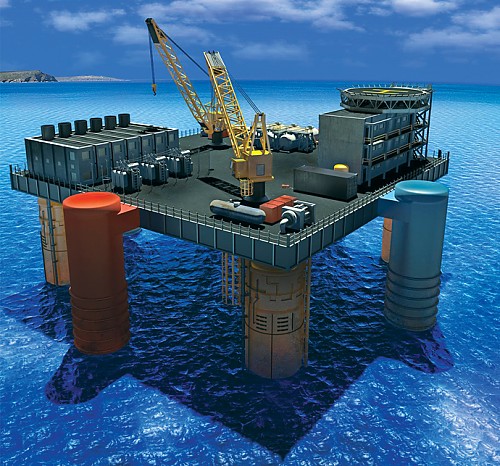Secret Clean Energy Stash Discovered in Oceans
Lockheed Martin, the company better known for airborne innovation, is developing a way to mine renewable energy that is literally just sitting there in the ocean, waiting for someone to reach out and grab it. The new system, a twist on ocean thermal energy conversion, is considered one of those “disruptive” technologies that could bring about a sea change (sorry, couldn’t resist) in the way ships, robots and other oceangoing equipment power their operations, in addition to providing a steady supply of energy for landlubbers.
Hidden Energy in the Ocean
According to Oak Ridge National Laboratory’s Jim Pearce, ocean thermal conversion (OTEC) systems located in tropical waters could generate up to five terawatts of power without affecting the ambient temperature of the ocean. That would be five terawatts of clean, renewable “base” power. Like geothermal, OTEC systems operate continuously and could potentially provide a reliable base of supply to back up intermittent sources like wind and solar (a terawatt is a trillion watts, by the way).
Mining Ocean Thermal Energy
For now, the key to ocean thermal energy is locked away at about 3,000 feet below the surface. In the tropics, the temperature difference between that depth and the surface is about 20 degrees Celsius. The OTEC system would use this naturally available supply of warm and cold water to run a power plant based on Rankine engine technology. Also known as Schoell engines, Rankine engines are external combustion engines in which a piston is moved by cycles of heat and cold.
Corrosion is the Rub for OTEC
One obstacle in the path of a commercially viable, large scale OTEC plant is the cost of a heat exchanger needed to intensify the energy of the warm surface water. Last month, Lockheed shipped a new 20-foot tall heat exchanger to Hawaii for a six month round of testing. The exchanger was constructed using a process called friction stir welding to reduce corrosion. The process, which involves heating metal to a plastic state rather than melting it, has been used successfully on ships and spacecraft. This is its first use on an ocean-going heat exchanger. With another new twist – the use of graphite foam to boost the
efficiency of the heat exchangers – there could be a cost savings of about 50 percent.

Hidden Energy in the Ocean
According to Oak Ridge National Laboratory’s Jim Pearce, ocean thermal conversion (OTEC) systems located in tropical waters could generate up to five terawatts of power without affecting the ambient temperature of the ocean. That would be five terawatts of clean, renewable “base” power. Like geothermal, OTEC systems operate continuously and could potentially provide a reliable base of supply to back up intermittent sources like wind and solar (a terawatt is a trillion watts, by the way).
Mining Ocean Thermal Energy
For now, the key to ocean thermal energy is locked away at about 3,000 feet below the surface. In the tropics, the temperature difference between that depth and the surface is about 20 degrees Celsius. The OTEC system would use this naturally available supply of warm and cold water to run a power plant based on Rankine engine technology. Also known as Schoell engines, Rankine engines are external combustion engines in which a piston is moved by cycles of heat and cold.
Corrosion is the Rub for OTEC
One obstacle in the path of a commercially viable, large scale OTEC plant is the cost of a heat exchanger needed to intensify the energy of the warm surface water. Last month, Lockheed shipped a new 20-foot tall heat exchanger to Hawaii for a six month round of testing. The exchanger was constructed using a process called friction stir welding to reduce corrosion. The process, which involves heating metal to a plastic state rather than melting it, has been used successfully on ships and spacecraft. This is its first use on an ocean-going heat exchanger. With another new twist – the use of graphite foam to boost the
efficiency of the heat exchangers – there could be a cost savings of about 50 percent.

You can return to the main Market News page, or press the Back button on your browser.

